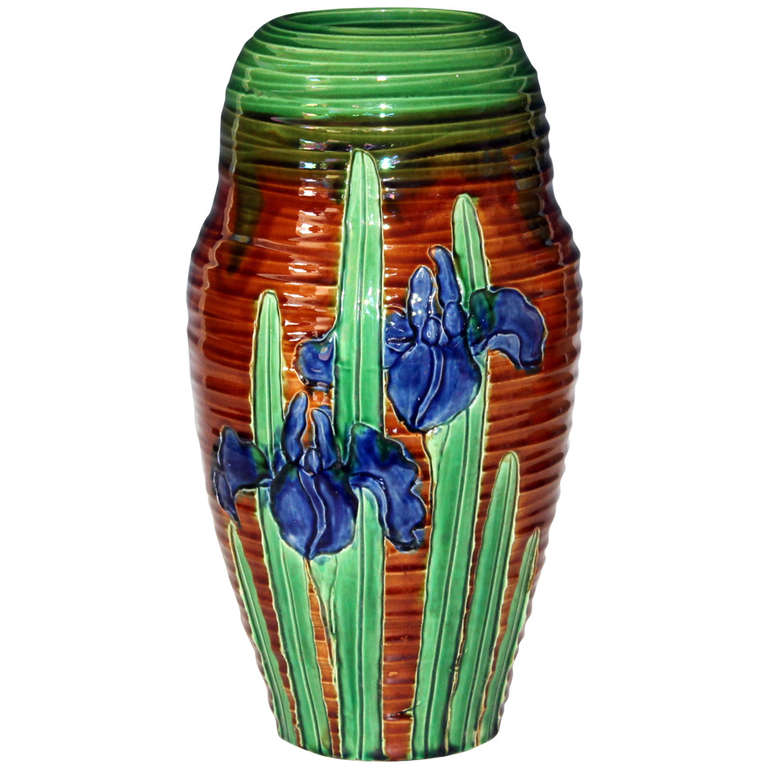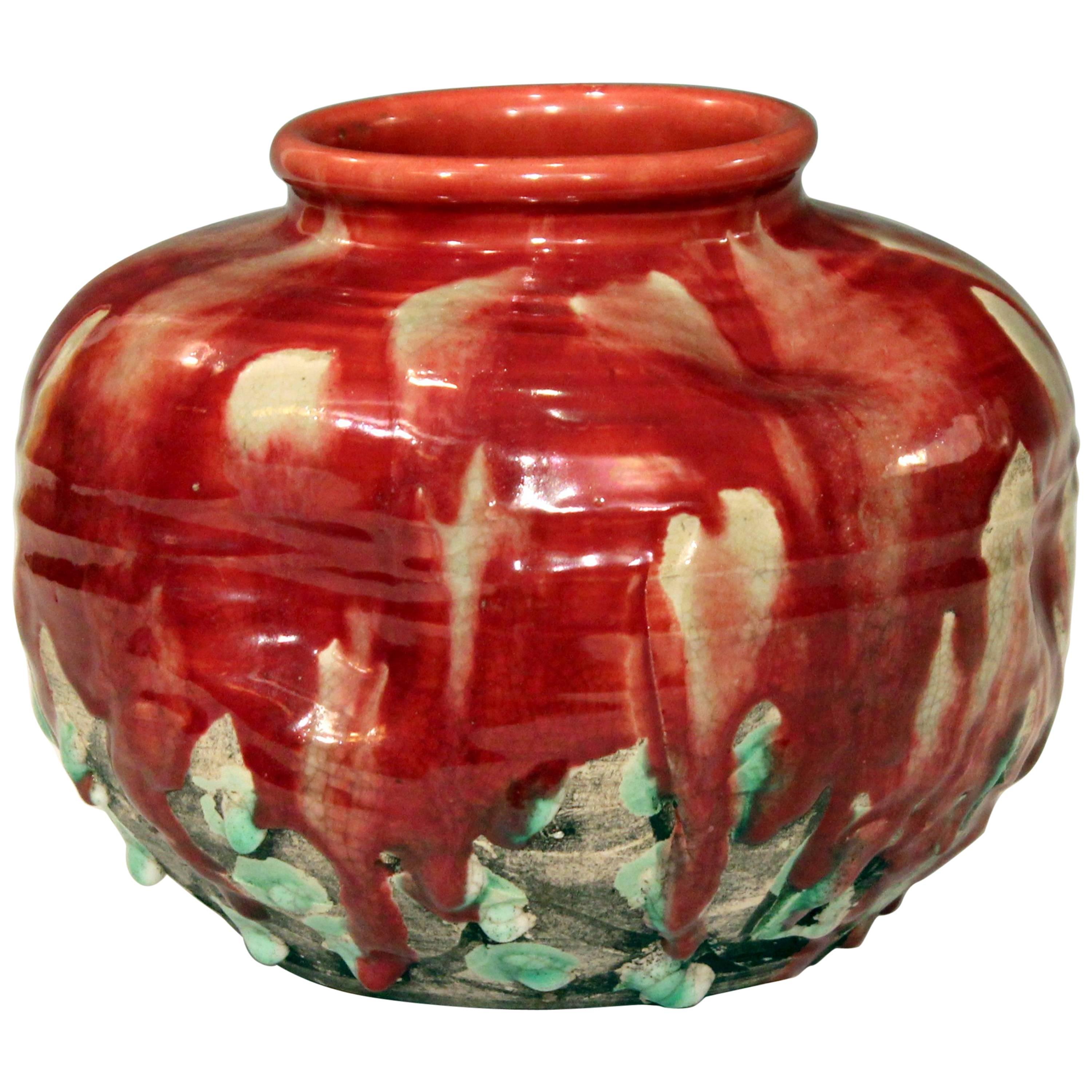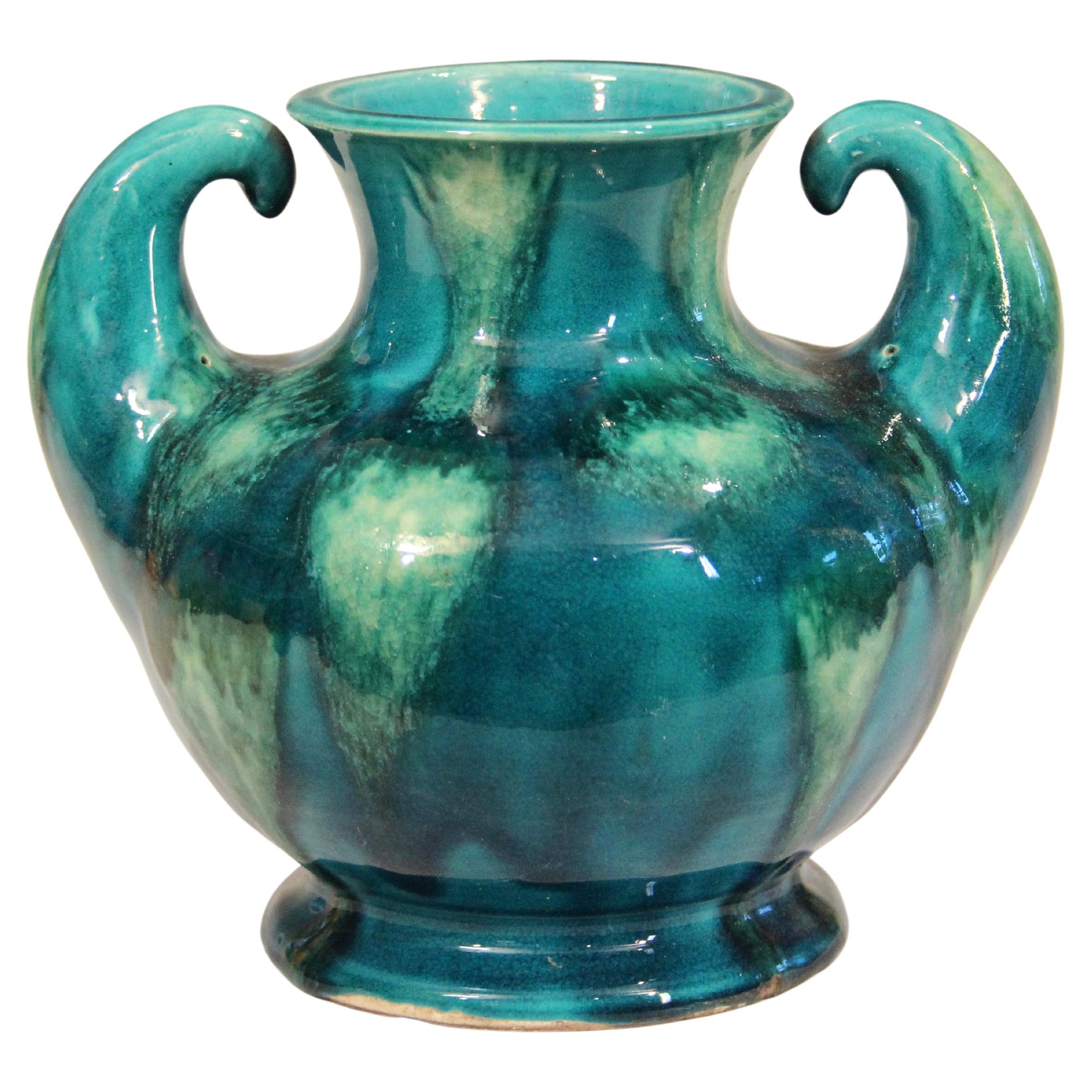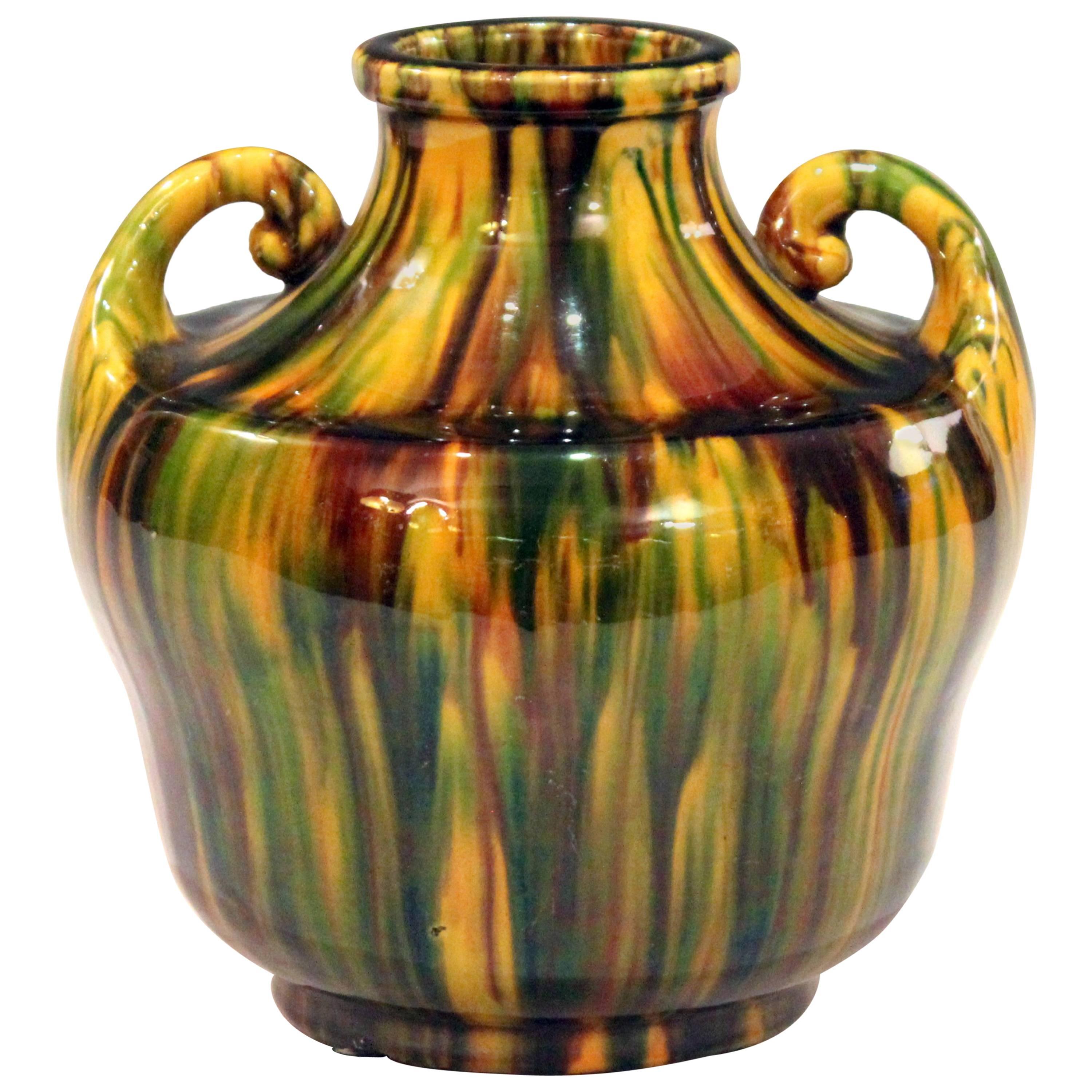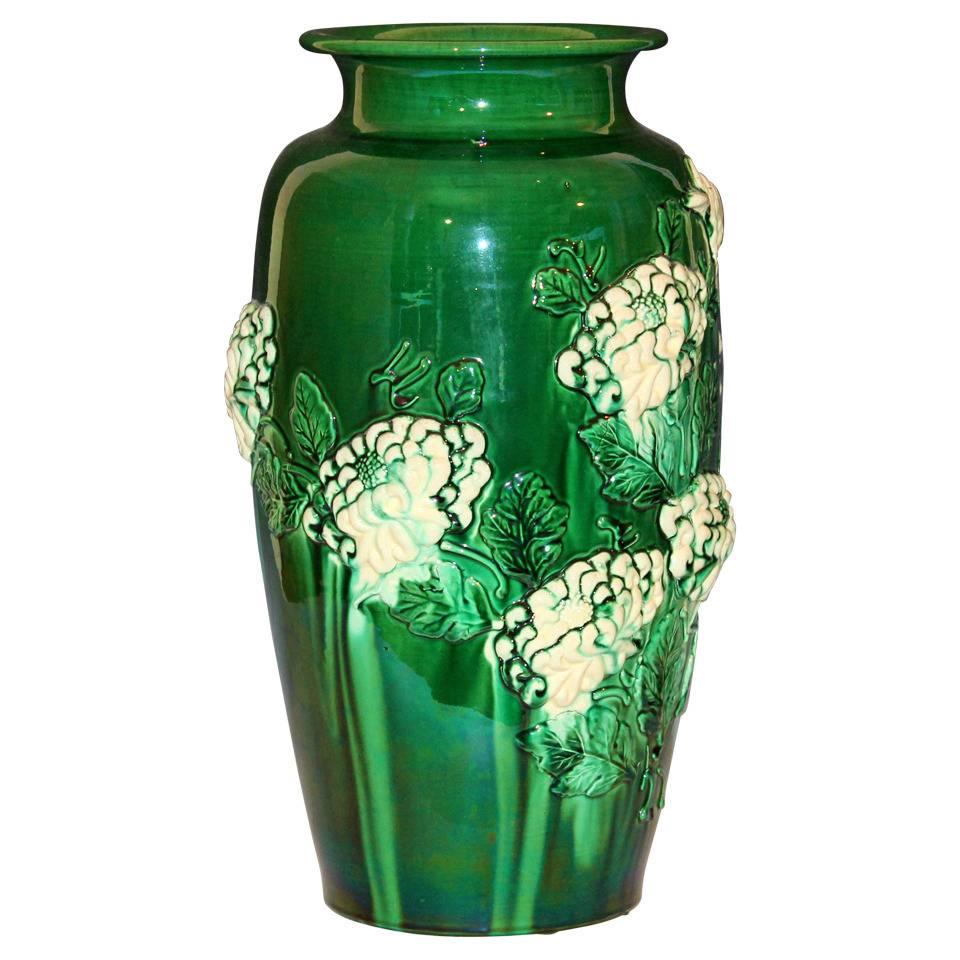Items Similar to Japanese Art Nouveau, Awaji Ware Art Studio Pottery Flower Vase, Ca. 1900
Want more images or videos?
Request additional images or videos from the seller
1 of 9
Japanese Art Nouveau, Awaji Ware Art Studio Pottery Flower Vase, Ca. 1900
About the Item
DIMENSIONS:
Height: 12.5 inches
Width: 6.75 inches
Depth: 6.75 inches
ABOUT AWAJI POTTERY
Awaji pottery was made on the Japanese island of the same name between 1830 and 1939. Most of the pieces that we see here in the West were made sometime between the mid 1870's when Awaji began exporting pottery, and the mid to late 1930's when the last of the kilns closed. Awaji pottery comes in an abundant variety of shapes, colors, and decorative techniques. The glazes are often brilliant in tone and most are translucent and finely crackled. The ware is sometimes mistaken by the uninitiated for European majolica or American art pottery. Unlike majolica and the vast majority of Western art pottery, most Awaji pottery is robustly hand-thrown, with only small and complex forms molded. Some of the earlier ware is delicately potted, but the majority of Awaji-ware is more stoutly constructed and pleasantly balanced. The Awaji potters were masters of their craft who had an innate feel for the possibilities of the clay form. The result of their efforts is a pottery of exceptionally lively forms that have an informal and genuine feel, devoid of fussiness and pretension.
The ceramic body (or paste) is made of high-fired, white or cream colored clay that borders on stoneware. The formula apparently changed over time and varied from pink or buff, to white to grey. The glazes are lead based which gives the colors brilliance and makes the translucent enamels glassy and often iridescent. The most common Awaji glaze colors are a grass green, yellow that can range from pale lemon to deep amber, cobalt blue, and aubergine. Other glazes are a light green, dusty blue, light and dark turquoise, mirror-black, and burgundy. The Awaji potters were adept at creating unadorned monochromes, two-tone glazes, three-color glazes (sancai), incised decoration (most commonly featuring irises), and applied relief decoration.
ABOUT AWAJI ISLAND
Awaji is an island in Japan’s inland sea between Honshu, the largest of Japan’s four main islands, and Shikoku, which is the smallest. The island is known for its beautiful scenery and quaint fishing villages which have attracted artists seeking retreat and inspiration for centuries. There is a renowned puppet theatre, ningyo joruri, which performs traditional dramas on the island which has traveled internationally. The narrow channel between Awaji and Shikoku is the site of the dramatic Naruto whirlpools featured in Japanese legend, which are caused by the tidal flow in and out of the inland sea. Awaji is now connected to Honshu by the Kobe-Awaji Bridge, which is the longest suspension bridge in the world.
ABOUT AWAJI KILNS
The first kiln on Awaji was started in 1831 by a doctor named Minpei in the village of Iga. Minpei was an energetic man of some means with wide ranging interests. He is known to have been a doctor, a talented writer, a renowned chajin (tea ceremony master), a soy sauce factory owner, and run a large fishing cooperative before devoting all of his energies to ceramic manufacture. In 1834, Ogata Shuhei, a highly esteemed Kyoto potter, came to work with Minpei for two years. A wide variety of fine wares were made in the fifty years which followed. The kiln was known for fine Satsuma-type pieces in the Kyoto or Awata style with elaborately glazed geometric designs and aptly executed foliage and wildlife. Minpei also mastered underglaze-blue decoration, carved celadons, ceramics that cleverly imitated bronze vessels, and bright yellow and green monochromes with incised designs. In 1842, the provincial Daimyo, or Governor, came to visit the operation and granted Minpei an official kiln status. Minpei retired in 1862, leaving the kiln to his son Rikita and nephew Sanpei.
By the 1870's, Rikita and Sanpei were each running kilns of their own and exhibiting in the International Exhibitions, where their wares were well received. In the late 1870's, Christopher Dresser, the influential British designer, visited the two kilns and ordered examples of each to be shipped back to England for study. In 1883, Rikita sold his works to a group that called the kiln Danto—which means “Group” in Japanese. Though Sanpei did not begin production at his own kiln until about 1870, his operation quickly became the larger of the two. A third kiln was set up in Awaji's capital, Sumoto, in 1883 by Tamura Kyuhei.
Some of the artists in Awaji evidently maintained a relationship with their counterparts in Kyoto. Pieces from each region continued to share similar raw materials and processes as well as nearly identical forms, glazes, and decorative techniques. They each used cream colored pottery clay with brilliant enamel glazes, fired to approximately the same temperature. Each used the point bottle form and the popular squared buttress handle form.
Through the 1880's and 90's, the Danto and Sanpei kilns, evidently influenced by their clients in the West, began to shift their styles. As the export market developed Awaji pottery evolved from a distinctive regional style intended for domestic consumption to a pottery influenced by international tastes and markets. Despite this influence from outside pressures, the Awaji pottery retained its unique regional flavor. The forms became simpler and more organic; the decoration parsed to a spare and bold, but still spontaneously confident manner. Bright green, yellow, and blue glaze grounds were used both as monochromes to show off the forms, or as grounds under carved, incised and applied decorations highlighted with other blending and contrasting colors.
The Awaji potters were obviously aware of the International art movements of the late 19th and early 20th centuries. In response to the Art Nouveau style they used sensuous, organic, forms with sweeping curves and handles. These forms were accented by two tone glazes which melted into one another with hypnotic effect. These forms gave way to the boldly geometric style of the Art Deco movement. These are characterized by architecturally squared buttress handles and feet, along with rocket and other space-age forms. The Deco then gave way to the Modern Movement. The pieces made during this last long movement are some of the most interesting of the Awaji output.
During this final period (1922 - 1939), Sanpei's kiln produced an impressive array of extremely creative art pottery. A number of new glazes were developed, many of which are now used in striking flambé mixes. The two kilns closed in 1939 as the export market dropped off preceding World War II.
- Creator:Awaji Pottery (Maker)
- Dimensions:Height: 12.5 in (31.75 cm)Width: 6.75 in (17.15 cm)Depth: 6.75 in (17.15 cm)
- Style:Art Nouveau (Of the Period)
- Materials and Techniques:
- Place of Origin:
- Period:1900-1909
- Date of Manufacture:circa 1900
- Condition:Wear consistent with age and use. We make our best effort to provide a fair and descriptive condition report. Please examine photos attentively, as they are an integral part of the description. Send us a message to request more details or discuss price.
- Seller Location:New York, NY
- Reference Number:1stDibs: LU2819330230252
About the Seller
5.0
Vetted Seller
These experienced sellers undergo a comprehensive evaluation by our team of in-house experts.
Established in 1993
1stDibs seller since 2017
68 sales on 1stDibs
Typical response time: 2 hours
- ShippingRetrieving quote...Ships From: New York, NY
- Return PolicyA return for this item may be initiated within 10 days of delivery.
More From This SellerView All
- Japanese Art Nouveau Awaji Ware Art Studio Pottery Flower Vase, ca. 1900sLocated in New York, NYJapanese Art Nouveau Flower Vase Awaji Ware Art Studio Pottery ca. 1900s ABOUT AWAJI WARE ART STUDIO POTTERY Awaji pottery was made on the Japanese island of the same name between...Category
Antique Early 1900s Japanese Art Nouveau Vases
MaterialsPottery
- Japanese Kyoto Fuzan Satsuma Ware Double-Handled Vase, Meiji Period, ca. 1900Located in New York, NYThis beautiful end of Meiji Period Japanese Kyoto Fuzan Satsuma Ware double-handled vase has a gold plated intricate infinite circular relief pattern design and two images of goddess...Category
Antique Early 1900s Japanese Taisho Vases
MaterialsPorcelain
- French Art Nouveau Patinated Bronze Sculptural Iris Vase, ca. 1900Located in New York, NYABOUT IRIS The iris is a special and mysterious flower. Not only because of its striking appearance, but also from an artistic and historical point of view. It is also like a work of art, as though created by Mother Nature. The unique leaves of this plant not only create wonderful shadow casts, but also look as if they were painted by hand. It's no wonder that iris acts as the muse for countless artists, and can be seen in many famous works of art. The iris was first spotted in the time of Pharaoh Thutmose, in 1504 BC. He had the iris inscribed into the wall reliefs of a temple as a sign of his power, as well as decorating his sceptre with motifs of the flower. Since then, the iris has been a symbol of victory in Egypt. But the symbolism of the iris goes further than that. In Japan, the flower represents courage and is the symbol of the boys' festival. In Islamic cultures, the iris is a symbol of prosperity. In Europe, the flower was a popular weapon symbol in the Middle Ages and stood for chivalry. And in Christianity, the iris was seen as a symbol of the trinity because of its three-part flowers. With more than 300 varieties, the iris is now the most popular flower among growers and gardeners following the rose. Countless artists use the iris in their works and the flower is present in all eras. You can see the flower on furniture, vases, jewelry, fabrics, sculptures, coats of arms and much more. Did you know that the iris is also called the sword lily? It's not a coincidence that it used to symbolize physical and emotional pain and suffering caused by a weapon. We also see the flower in religious art, where it's often associated with Mary and Jesus. The iris is also associated with the Greek goddess Iris, where the flower symbolizes reconciliation and divine messages. This is also reflected in many paintings. Finally, the iris is also visible in Dutch and Flemish still-life paintings. This can be in a religious form, incorporated into an object or as a decorative flower. In the Art Nouveau art movement, the iris (along with other plants, such as the birch) was often used as an expression of feminine beauty. With its almost otherworldly appearance, the iris is perfectly suited to the Art Nouveau aesthetic and is featured in many well-known works of art. The poet of that era, Hermann Hesse...Category
Antique Early 1900s French Art Nouveau Planters, Cachepots and Jardinières
MaterialsBronze
- Japanese Art Nouveau Meiji Period Patinated Bronze Vase, circa 1900Located in New York, NYAlthough unmarked, this rare and important, grand but at the same exquisite patinated bronze vase has just a very few little details, defying the shape of the handles, as well as the...Category
Antique Early 1900s Japanese Art Nouveau Vases
MaterialsBronze
- French Art Nouveau Iridescent Stoneware & Bronze Vase or Cachepot, ca. 1900sLocated in New York, NYFrench Art Nouveau Ocean Life Theme Vase Cachepot Iridescent Stoneware & Patinated Bronze Crab Appliqué ca. 1900s ABOUT We present here a most unusual and utterly decorative Fren...Category
Antique Early 1900s French Art Nouveau Vases
MaterialsStoneware
- After Loetz, Bohemian Jugendstil Iridescent Art-Glass Flower Vase, ca. 1900By Loetz GlassLocated in New York, NYThis large elegant, museum quality flower vase was probably made by Johann LOETZ Witwe Glassworks (Klostermühle, Bohemia, circa 1900) is a superior example of Jugendstil ~ Art Nouveau luxury object. The semi-translucent art glass strikes a spectator not only with the uniqueness of its surface, reminiscent of crocodile skin, but also with unexpected color scheme - a combination of dark brown, old gold and green, covered with craquelure; against the background of iridescent violet. The vase is framed by outstandingly designed bronzed & patinated pewter mounting, consisting of simple large handles, almost geometric-form; with one wreath of leaves, crowning the neck; and the second, forming a base. The simplicity of the forms both, the glass vessel and the mounting are generating extremely interesting decorative effects, inherent exclusively to Jugendstil ~ Art Nouveau era. LOETZ Witwe Glassworks In 1836, Johann Eisner established a glassworks in the Southern Bohemian town of Klostermühle, today part of the Czech Republic. The Art Nouveau Period was the glory years of the company. The glassworks created large numbers of its own new designs of iridescent, trailing art nouveau glass, sometimes in collaboration with well-known artists and designers like Marie Kirschner and Franz Hofstötter (aka Franz Hofstätter). The company’s success during this period had two prime drivers – the technical expertise of Prochaska and the business acumen of von Spaun. Loetz Witwe created many of its own designs, and also supplied glass commissioned by major customers like E. Bakolowits (Vienna) and Max Emanuel...Category
Antique Early 1900s Czech Art Nouveau Vases
MaterialsArt Glass
You May Also Like
- Awaji Pottery Art Nouveau Carved Iris VaseBy Awaji PotteryLocated in Wilton, CTAwaji Pottery vase with blooming irises carved into accentuated throw ribs. The blue and green irises set aglow against the warm brown ground. Measures: 12 1/2" high, 6 1/2" diameter...Category
Early 20th Century Japanese Art Nouveau Ceramics
MaterialsPottery
- Awaji Pottery Art Studio Japanese Manipulated Drip Flambe Glaze Jar VaseBy Awaji PotteryLocated in Wilton, CTLarge vintage Awaji pottery vase, carved and dented and with thick, dripping glaze, circa 1930. Impressed marks. 6 1/2" high, 8 1/2" diameter. Excellent condition.Category
Vintage 1930s Japanese Modern Vases
MaterialsPottery
- Awaji Pottery Art Deco Japanese Vintage Studio Vase in Yellow Flambe GlazeBy Awaji PotteryLocated in Wilton, CTAwaji Pottery vase in Art Deco form with little handles curled over the wide, recessed shoulder and striking yellow flambe glaze, circa 1930. Impressed marks. Measure: 6 1/8" high, 6...Category
Vintage 1930s Japanese Art Deco Vases
MaterialsPottery
- Awaji Pottery Art Deco Japanese Vintage Studio Muscle Vase Blue Green FlambeBy Awaji PotteryLocated in Wilton, CTAwaji Pottery "muscle" vase in Art Deco form with outstreched handles and frothy blue green flambe glaze, circa 1930. Impressed marks. Measure: 6" high, 7 1/2" across handles, 6" dee...Category
Vintage 1930s Japanese Art Deco Vases
MaterialsPottery
- Large Japanese Awaji Pottery Chrysanthemum VaseBy Awaji PotteryLocated in Wilton, CTLarge Awaji pottery vase with sprigged chrysanthemums and green and white glazes, circa 1930. Measures: 18 1/4" high, 9 1/2" diameter. Excellent condition.Category
Vintage 1930s Japanese Arts and Crafts Ceramics
MaterialsPottery
- Antique Awaji Pottery Art Nouveau Four Handle Green VaseBy Awaji PotteryLocated in Wilton, CTAntique Awaji pottery Art Nouveau form vase with four willowy handles emanating from a squared shoulder in deep green glaze, circa 1910. Measures: 14 1/2" high, 7 1/2" diameter. Dri...Category
Vintage 1910s Japanese Arts and Crafts Vases
MaterialsPottery
Recently Viewed
View AllMore Ways To Browse
Antique Kilns
Manufacture Japanese
Pottery Three
Antique White Pottery
Blue White Pottery
Blue And White Pottery
Antique Pottery Other Antiques
Blue Green Pottery
White Pottery Large
Large Blue Pottery
Weller Antique Pottery
Pottery Mold
Mid Century Sets Of Pottery
Group Of Pottery
New Hall Pottery
Antique Yellow Pottery
Antique Glaze Colors
Antique Japanese Pottery

